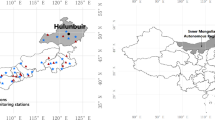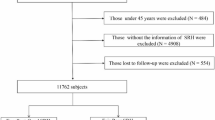Abstract
There has been no evidence on the effects of birth season and birth month on mortality in China. We aimed to explore the association between birth season, birth month and all-cause and cardiovascular disease (CVD) death. A population-based sample of 21,338 Chinese rural participants aged ≥35 years at baseline was included in our analysis. Age and multivariable adjusted Cox proportional hazards models were used to estimate hazard ratios (HRs) and 95% confidence intervals (95% CIs) for the relationship between astronomical birth season (autumn as the reference), birth month (November as the reference), and all-cause and CVD mortality. During a median follow-up period of 11.9 years, 2,207 people died from all-cause and 1,214 people were attributed to CVD death. In multivariable adjusted analyses, for all-cause death, spring and winter had HRs (95% CIs) of 1.134 (1.005–1.280) and 1.162 (1.038–1.301), respectively; January, March, May, and August had HRs (95% CIs) of 1.249 (1.027–1.518), 1.234 (1.008–1.512), 1.276 (1.037–1.571), and 1.232 (1.003–1.513), respectively. For CVD death, spring and winter with HRs (95% CIs) of mortality were 1.232 (1.048–1.449) and 1.174 (1.007–1.369), respectively; March with HR (95% CI) of mortality were 1.343 (1.030–1.750) (all P < 0.05). Our study indicated that people born in the winter or spring were significantly associated with all-cause and cardiovascular disease mortality in rural areas of China.
This is a preview of subscription content, access via your institution
Access options
Subscribe to this journal
Receive 12 digital issues and online access to articles
$119.00 per year
only $9.92 per issue
Buy this article
- Purchase on SpringerLink
- Instant access to full article PDF
Prices may be subject to local taxes which are calculated during checkout



Similar content being viewed by others
References
Zhu N, Zhang D, Wang W, Li X, Yang B, Song J, et al. A novel coronavirus from patients with pneumonia in China, 2019. N Engl J Med. 2020;382:727–33.
Gluckman PD, Hanson MA. Living with the past: evolution, development, and patterns of disease. Science. 2004;305:1733–6.
Rinaudo P, Wang E. Fetal programming and metabolic syndrome. Annu Rev Physiol. 2012;74:107–30.
Boland MR, Shahn Z, Madigan D, Hripcsak G, Tatonetti NP. Birth month affects lifetime disease risk: a phenome-wide method. J Am Med Inform Assoc. 2015;22:1042–53.
Li L, Boland MR, Miotto R, Tatonetti NP, Dudley JT. Replicating cardiovascular condition-birth month associations. Sci Rep. 2016;6:33166.
GBD 2017 Causes of Death Collaborators. Global, regional, and national age-sex-specific mortality for 282 causes of death in 195 countries and territories, 1980–2017: a systematic analysis for the Global Burden of Disease Study 2017. Lancet. 2018;392:1736–88.
GBD 2017 Causes of Death Collaborators. Global, regional, and national age-sex-specific mortality and life expectancy, 1950–2017: a systematic analysis for the Global Burden of Disease Study 2017. Lancet. 2018;392:1684–735.
Zhou M, Wang H, Zhu J, Chen W, Wang L, Liu S, et al. Cause-specific mortality for 240 causes in China during 1990-2013: a systematic subnational analysis for the Global Burden of Disease Study 2013. Lancet. 2016;387:251–72.
Yang G, Wang Y, Zeng Y, Gao GF, Liang X, Zhou M, et al. Rapid health transition in China, 1990-2010: findings from the Global Burden of Disease Study 2010. Lancet. 2013;381:1987–2015.
Zhao D, Liu J, Wang M, Zhang X, Zhou M. Epidemiology of cardiovascular disease in China: current features and implications. Nat Rev Cardiol. 2019;16:203–12.
Zheng L, Sun Z, Zhang X, Li J, Hu D, Chen J, et al. Predictive value for the rural Chinese population of the Framingham hypertension risk model: results from Liaoning Province. Am J Hypertens. 2014;27:409–14.
Zheng L, Zhang Z, Sun Z, Li J, Zhang X, Xu C, et al. The association between body mass index and incident hypertension in rural women in China. Eur J Clin Nutr. 2010;64:769–75.
Zhang Y, Devore EE, Strohmaier S, Grodstein F, Schernhammer ES. Birth month, birth season, and overall and cardiovascular disease mortality in US women: prospective cohort study. BMJ. 2019;367:l6058.
Gavrilov LA, Gavrilova NS. Season of birth and exceptional longevity: comparative study of american centenarians, their siblings, and spouses. J Aging Res. 2011;2011:104616.
Ueda P, Bonamy AE, Granath F, Cnattingius S. Month of birth and mortality in Sweden: a nation-wide population-based cohort study. PLoS One. 2013;8:e56425.
Lerchl A. Month of birth and life expectancy: role of gender and age in a comparative approach. Naturwissenschaften. 2004;91:422–5.
Doblhammer G, Vaupel JW. Lifespan depends on month of birth. Proc Natl Acad Sci USA. 2001;98:2934–9.
Sohn K. The influence of birth season on mortality in the United States. Am J Hum Biol. 2016;28:662–70.
Stoupel E, Tamoshiunas A, Radishauskas R, Abramson E, Bernotiene G, Bacevichiene M. Birth month and longevity: birth month of victims of sudden (SCD, </=1 h) and rapid (RCD, </=24 h) cardiac deaths. J Basic Clin Physiol Pharm. 2013;24:235–9.
Schumann B, Haggstrom Lundevaller E, Karlsson L. Weather extremes and perinatal mortality - Seasonal and ethnic differences in northern Sweden, 1800-1895. PLoS One. 2019;14:e0223538.
Karlsson L, Lundevaller E, Schumann B. The association between cold extremes and neonatal mortality in Swedish Sapmi from 1800 to 1895. Glob Health Action. 2019;12:1623609.
Painter RC, Roseboom TJ, Bleker OP. Prenatal exposure to the Dutch famine and disease in later life: an overview. Reprod Toxicol. 2005;20:345–52.
Marciniak A, Patro-Małysza J, Kimber-Trojnar Z, Marciniak B, Oleszczuk J, Leszczyńska-Gorzelak B. Fetal programming of the metabolic syndrome. Taiwan J Obstet Gynecol. 2017;56:133–8.
Villar J, Belizan JM. The timing factor in the pathophysiology of the intrauterine growth retardation syndrome. Obstet Gynecol Surv. 1982;37:499–506.
Inoue Y, Stickley A, Yazawa A, Fujiwara T, Konndo K, Kondo N. Month of birth is associated with mortality among older people in Japan: findings from the JAGES cohort. Chronobiol Int. 2016;33:441–7.
Auger N, Fraser WD, Sauve R, Bilodeau-Bertrand M, Kosatsky T. Risk of congenital heart defects after ambient heat exposure early in pregnancy. Environ Health Perspect. 2017;125:8–14.
Arbuthnott KG, Hajat S. The health effects of hotter summers and heat waves in the population of the United Kingdom: a review of the evidence. Environ Health. 2017;16:119.
Pasco JA, Wark JD, Carlin JB, Ponsonby AL, Vuillermin PJ, Morley R. Maternal vitamin D in pregnancy may influence not only offspring bone mass but other aspects of musculoskeletal health and adiposity. Med Hypotheses. 2008;71:266–9.
Tornhammar P, Ueda P, Hult M, Simila H, Eyles D, Norman M. Season of birth, neonatal vitamin D status, and cardiovascular disease risk at 35 years of age: a cohort study from Sweden. Am J Clin Nutr. 2014;99:472–8.
Acknowledgements
All of the investigators and staff members were gratefully acknowledged. Thanks for all the enthusiastic participants.
Funding
This research was supported by funds from National Key R&D Program of China [Grant#2018YFC1311600], Xingliao Talents Program of Liaoning Province [Grant #XLYC1808036], National Nature Science Foundation of China [No. 81773510], National Key R&D Program of China [Grant #2017YFC1307600], and 345 Talent Project of Shengjing Hospital.
Author information
Authors and Affiliations
Contributions
ZG: Conceptualization; Writing—original draft. SL: Methodology; Validation. YD: Formal analysis. RG: Investigation. YW: Data curation. ZS: Supervision; Resources. LX: Investigation; Resources. YS: Project administration. LZ: Conceptualization; Writing—review and editing.
Corresponding authors
Ethics declarations
Conflict of interest
The authors declare that they have no conflict of interest.
Additional information
Publisher’s note Springer Nature remains neutral with regard to jurisdictional claims in published maps and institutional affiliations.
Supplementary information
Rights and permissions
About this article
Cite this article
Gao, Z., Liu, S., Dai, Y. et al. Born in winter or spring more susceptible to all-cause and cardiovascular disease death in rural areas of China: results from a 11.9-year follow-up study. J Hum Hypertens 35, 1170–1179 (2021). https://doi.org/10.1038/s41371-020-00432-0
Received:
Revised:
Accepted:
Published:
Issue date:
DOI: https://doi.org/10.1038/s41371-020-00432-0



